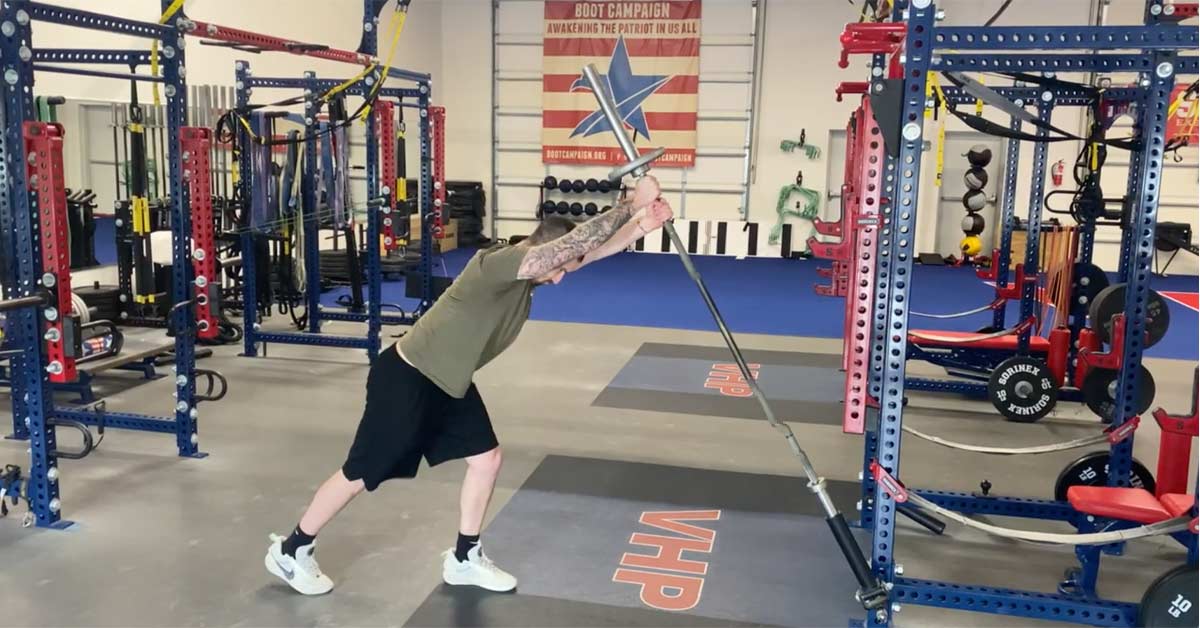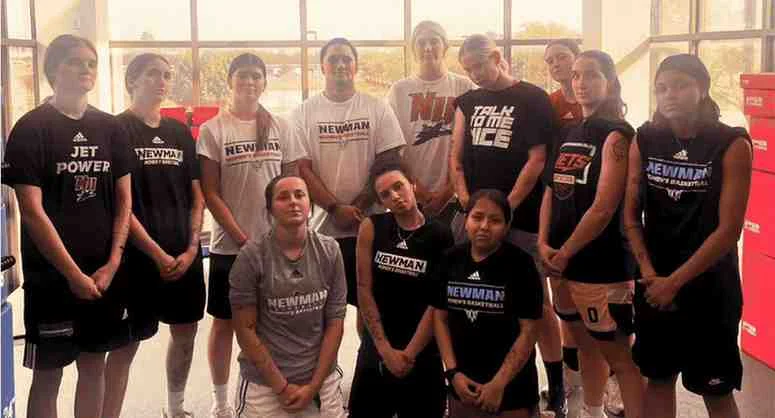Despite tremendous growth over the last several decades, the human performance industry still has some work to do. Strength and conditioning coaches, physiotherapists, and others within the human performance umbrella typically have two benchmarks for evaluating their effectiveness: pre/post diagnostic testing and rate of injury in sport. While we’ve seen some truly remarkable improvements in conventional testing performance (i.e., NFL Combine), the same cannot be said for the injury rates.1–3 Considering rapid advances in technology allowing us to track a host of biometrics, physical outputs, and even performance data, it would seem paradoxical that we haven’t been able to demonstrate similar hallmark achievements regarding injury rates.
It has been well-established that injuries, collectively, are not preventable. However, it should be equally understood that what we do matters, and good training coupled with adequate recovery will undeniably improve an athlete’s odds for staying healthy throughout their season/career.
My time at VHP has afforded me a somewhat unique perspective on the injury management and restoration component of sport performance. For the last five years, I’ve worked exclusively with Special Operations and Special Forces personnel, which has been a tremendous opportunity, but it has not come with simplicity. The inherent focus of our work has been figuring out how to effectively train athletes at a high level despite expansive injury histories. When the majority of “conventional” S&C applications are not feasible, it has forced us to view movement from a different lens. And it is largely because of the demands of working with this population that I was eventually led down the fascia rabbit hole.
What I’ve come to find over the years is that the fascial system is a lynchpin to training, movement, and performance, says @danmode_vhp. Share on XWhat I’ve come to find over the years is that the fascial system is a lynchpin to training, movement, and performance. My theory as it relates to injuries is that we have maintained an overemphasis on training the musculoskeletal system while overlooking how to directly improve the resiliency of connective tissues. Having dramatic differences between muscular capacity and soft tissue resilience may be more of a culprit than we like to acknowledge, and this requires both a change in philosophy and the use of strength training and rehabilitative practices.
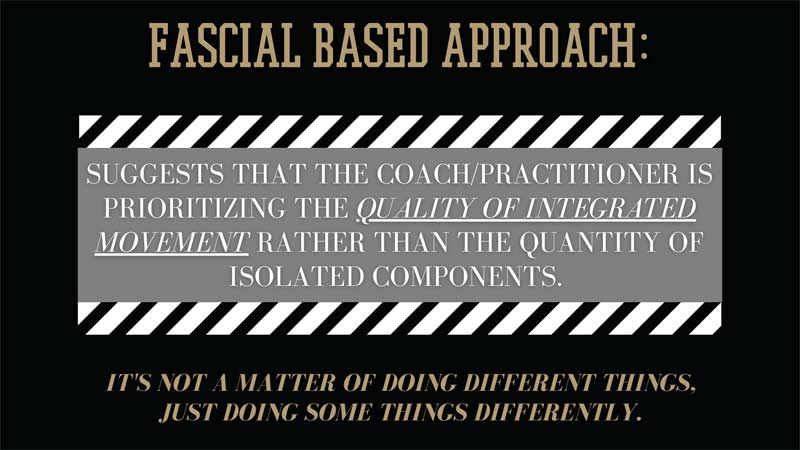
What Does a Fascial-Based Approach Mean?
Before we get into the training applications, allow me to first give a brief outline for why these fascial concepts should be considered in a sport performance setting. Fascia is a fibroelastic connective tissue that plays important roles in biological structure, movement, and function.4 In a laymen’s sense, you can think of fascia as being a global connective tissue that, quite literally, connects us from head to toe. Fascia is also highly enriched with proprioceptive bodies and free nerve endings that play critical roles in detecting external stimuli, movement coordination, and even spatial orientation.5 While fascia may not generate much force itself, as we know muscles and tendons do, fascia plays a critical role in coordinating and synergizing movement—which is essential for speed, power, and reactiveness.5
Ultimately, I believe there is a relative balance between muscular capacity and soft tissue (namely fascia) resiliency, and if there’s too much disparity between them, athletes will underperform and be at a greater risk for injuries to occur.
I’ve spoken about the fascial system at great lengths over the years, and along with several others, have continued to find success with applying this perspective toward human movement and performance. The biggest misconception when discussing fascial-based training is coaches assuming this indicates some sort of complete training overhaul: one in which all conventional exercises are done away with in favor of standing on Bosu balls and exclusively using mini-bands and shake weights. Not only is this, of course, untrue, but it also demonstrates a fundamental misunderstanding of what a fascial-based training approach really entails.
In the most empirical sense, I see a fascial-based training approach as prioritizing the quality of integrated movement rather than the quantity of isolated components. Thus, it’s not exactly a matter of doing different things, but rather, just doing some things differently.
I see a fascial-based training approach as prioritizing the quality of integrated movement rather than the quantity of isolated components, says @danmode_vhp. Share on XIt’s extremely important to recognize that the fascial system, like virtually any other biological system, is inextricably linked to the musculoskeletal system.6 So, if we wanted to be perfectly technical about this, everything is fascial-based training, just as everything is muscular-based training. As we’ll discuss in more detail throughout this article, organizing training to be more or less fascial focused is more reliant on the parameters in which training is performed than on the specific movements or exercises themselves. Moreover, a fascial approach does not negate or delegitimize most of what we consider to be a conventional approach. It’s really more of a change in the coach’s perspective of movement and training than it is the tangible X’s and O’s of sport performance.
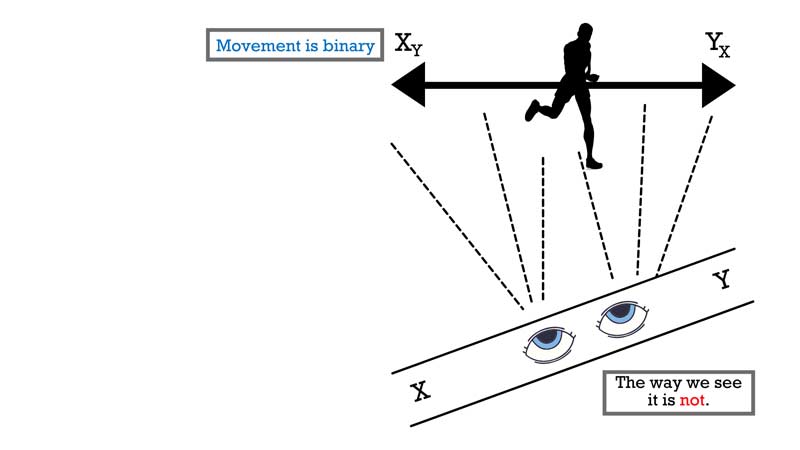
Fundamental Differences
Fundamentally, the primary difference I see between the two is whereas conventional approaches tend to focus on the progressive overload of specific movements or isolated parts, a fascial approach focuses more on the collective integration of global movement. Additionally, conventional thought suggests we emphasize multiple isolated components, whereas a fascial-based approach is derived from more of an integrative emphasis. By virtue, this will indicate that a fascial approach is going to be more core- or trunk-focused with less concern for segmental body parts or isolated movements. There is less demand for chasing numbers on specific lifts and less use of constrained, compound movements in the programming in general.
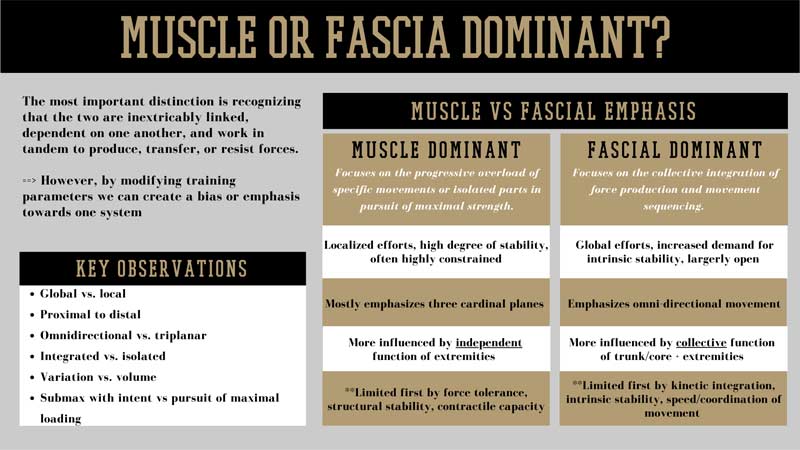
Where the conventional models adopted for sport performance are largely driven by mechanical progressive overload and a pursuit of maximal force outputs, the fascial-based model is more concerned with the sequencing and speeds of variable movements. Similarly, where conventional strength training is programmed accordingly to our three cardinal planes, fascial-based training is omnidirectional in nature. Rather than restricting athletes to three phantom planes we’ve created to simplify training strategies, why not challenge athletes to expand their ability to move across a multitude of vectors under varying loads and speeds with proficiency? I can’t think of many things more self-limiting than trying to reduce a sport to one or two planes of motion—that is really one of the greatest fallacies of our conventional academia.
I can’t think of many things more self-limiting than trying to reduce a sport to one or two planes of motion—that is really one of the greatest fallacies of conventional academia, says @danmode_vhp. Share on XGetting Started with Fascial-Based Training
As I alluded to above, taking a more fascial-focused approach to sport performance and human movement doesn’t require a complete destruction of your programming and training philosophies. Remember, this is not a matter of doing completely different things, just doing some things in a different way. There are several adjustments I’d consider low-hanging fruit that, irrespective of your population or training setting, can be implemented with ease and potentially have significant return for your athletes.
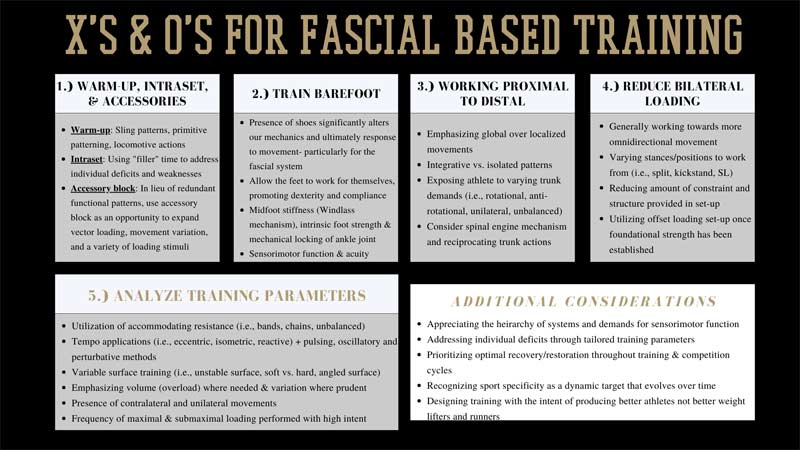
*Click here for graphic voiceover*
A simple adjustment like using a kickstand set up for deadlifts rather than bilateral is a subtle way to promote more fascial focus by creating more demand on unilateral function. Other subtleties such as using the landmine in lieu of a traditional barbell setup can go a long way.
The landmine offers a great opportunity for freedom of movement, allowing the athlete to work through a wide spectrum of vectors. The constant multiplanar nature of landmine movements increases demand for athletes to stabilize multiple planes of motion concurrently throughout the movement. This also provides a great deal of biofeedback to help athletes optimize their movement. The opportunity for a variety of vectors provides benefits by challenging the athlete in a way that is difficult to replicate with a traditional barbell setup.
Here are a couple of examples showing just that:
Video 1. Landmine Rebound Vertical Chop
I’d argue a lot of similar points for medicine ball work as well, with an added benefit of being able to use med balls in a projectile and decelerating manner. Between these two, we get a great bang for our buck, as both modalities promote total body (global) demands, and they are highly beneficial for sensorimotor function, movement coordination, and challenging cross-body patterns—all of which are quintessential to fascial-based training. The bonus is that both med ball and landmine work tend to be a great way to challenge the feet.
The bottom surface of the foot is an enriched bed of proprioceptors and free nerve endings that are constantly scanning and detecting input for the body.5 Sensorimotor proficiency and foot function are critical factors in not only sport performance but reducing the opportunities for injury. Training barefoot is a novel way to positively influence the fascial system, both mechanically and from a sensorimotor standpoint. Removing the cushioning surface and false stability of shoes allows the foot to work independently for itself, promoting a better interface with the ground. As a result, this allows the segments of the foot to work in compliance with one another, while also altering the joint positioning and thus muscular activation up the chain during dynamic actions.
Tying this right into the premise of analyzing your training parameters, the three areas I commonly point people to when getting started with fascial-based training approaches are the warm-up, intraset, and accessory blocks of training. These are three segments of training that tend to get put on autopilot, often being mistaken for mundane processes that have minimal influence on overall outcome. Contrary to this, I see these as key areas for improving overall training economy (better utilization of time), addressing individual deficits, and utilizing the opportunity to build variation into programming.
The three areas I commonly point people to when getting started with fascial-based training approaches are the warm-up, intraset, and accessory blocks of training, says @danmode_vhp. Share on XAs I see it, our primary block is where we emphasize the musculoskeletal structures through our primary lifts (i.e., squat, clean, jerk, dead), which are programmed for overload and consistency. The accessory block, however, is where I seek variation and variety—where we are more interested in vectors, ranges, and speeds of movement rather than just load or resistance. And for both primary lifts and our accessory work, I believe it’s important to reduce the amount of bilateral loading an athlete does as they become more experienced/trained.
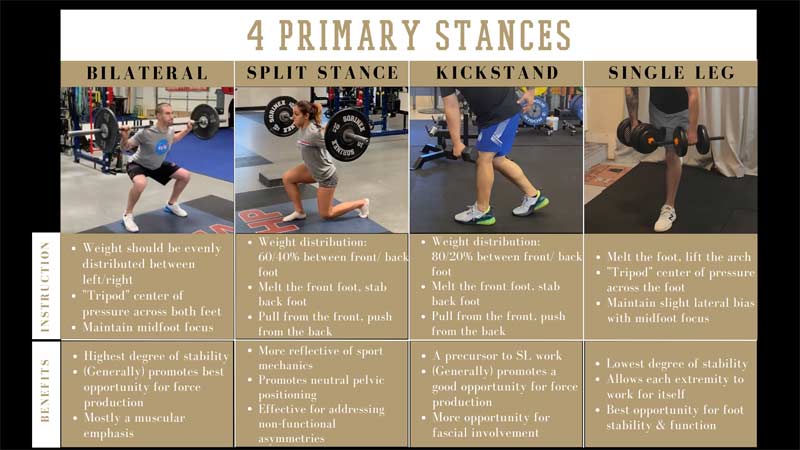
In addition to varying the position, another central principle for fascial training is working from proximal to distal. This is a widely practiced concept (first popularized by Stu McGill), in which we aspire to have proximal stiffness to create distal freedom or speed. Directly training the core is a non-negotiable component of strength training, but as you should know by now, this doesn’t mean a bunch of isolated crunches/planks/flutter kicks.
Effective core training starts with using global movements (e.g., med ball, landmine, jumps/bounds) that challenge the athlete to sequence force in a functional manner. This is also where I find value in combination movements (e.g., cable curtsy-to-lateral lunge), as redirecting force and momentum are critical foundations for sport. By improving the proximal stiffness—importantly, across a multitude of vectors—the fascia (and muscles) will have a better central anchor point, allowing the athlete to increase terminal speed of the limbs while optimizing power through a reduced loss of kinetic energy.

Why This Matters
The evolution of sport performance training has been impressive. We’ve continued to uncover some big rocks in our pursuit of cracking the codes for optimizing human movement and reducing the likelihood of injury. But we’re still not all the way there yet, and it’s vital we continue asking the right questions and examine the variables objectively. Personally, the muse that keeps feeding me is trying to understand precisely how much influence the fascial system has on performance and injury reduction.
I’ll be the first person to acknowledge my biases toward all things fascia, but I genuinely believe there is merit to this. I don’t believe our model is wrong; I just believe there is a transition point where the foundations of strength training (or “the basics”) become significantly less effective for preparing athletes for the demands of modern sport.
We need to develop strength, but we also need to make strength matter, and I feel that’s where fascial training concepts really show their value, says @danmode_vhp. Share on XFascia is what humanizes our movement, largely due to the robust sensorimotor function. But the fascial system is also a force amplifier, serving as a global connective tissue that aids us in connecting movement across all planes and vectors. We need to develop strength, but we also need to make strength matter, and I feel that’s where fascial training concepts really show their value. Remember, the goal is to make athletes better at their sport, not better at lifting weights.
References
1. “Injury Data Since 2015.” 2/7/22.
2. Menon, Arjun. “PFF Data Study: Breaking down WAIL and the most impactful injuries in the NFL last season.” 7/27/21.
3. Mack CD, Kent RW, Coughlin MJ, et al. “Incidence of Lower Extremity Injury in the National Football League: 2015 to 2018.” American Journal of Sports Medicine. 2020;48(9):2287–2294.
4. Findley T, Chaudhry H, Stecco A, and Roman, M. “Fascia research—a narrative review.” Journal of Body Movement Therapies. 2012;16(1):67–75.
5. Langevin, HM. “Fascia Mobility, Proprioception, and Myofascial Pain.” Life. 2021;11(7): 668.
6. Stecco C, Pirri C, Fede C, Yucesoy CA, De Caro R, and Stecco A. “Fascial or Muscle Stretching? A Narrative Review.” Applied Sciences. 2021;11(1):307.

